|
SAAB
|
1947 - Present |
Country: |
 |
|
Project 92
SAAB is the acronym for the Svenska Aeroplan Aktiebolaget - the Swedish Aeroplane Company. During World War 2 this company developed and tested an automobile (possibly the only European firm able to concern itself with a non-military vehicle in those years) the prototype of which was unveiled in 1947.
The new car's project number, 92, was adopted as the automobile's name, establishing a practice followed by the company for decades to come. The Saab 92 went into production in 1950, its 764 cc two-cylinder two-stroke engine of DKW type developing 25 bhp and driving the front wheels. Suspension was by torsion bars all round, and the round-shouldered aerodynamic body set a basic style approach which would become the hallmark of SAAB design.
The Rikspokalen
Good weight distribution, excellent roadholding and a strong but light steel body made it instantly attractive to rally drivers. Within two months of the delivery of the first 92, an example had already won the then largest Swedish rally, the Rikspokalen. By the end of 1950, 1246 cars had left the Trollhattan factory. Rallying, and the special needs of the rallyist, shaped the development of the Saab car thereafter.
In 1955 came the Model 93 - more powerful with a three-cylinder 748 cc engine giving 38 bhp, and coil spring/hydraulic shock-absorber suspension. The GT model of this car was tuned to do nearly 100 mph. In the same year, production was up to 5500, of which 226 were exported: a modest enough percentage, but the start of a major swing by Saab towards foreign markets - and foreign currency.
The next significant new Saab was the Model 95 in 1959, followed by the 96 in 1960 - and in that year Erik Carlsson achieved the first of three successive wins for Saab in the RAC Rally. In the early 1960s the Saabs were almost untouchable over the toughest rally stages - Carlsson taking the Monte Carlo Rally in 1962 and 1963. Export sales boomed as a result.
Swedish Car of the Year
In 1960, while Swedish sales of Saab reached 13,700, export sales were up to 11,400, with the US, Britain, and other Scandinavian developing as the most important foreign markets. The sixties also saw significant safety advances in Saab cars. In certain markets seat-belts were introduced as standard on the 96 - ten years before they became obligatory on the Swedish and US markets. And in 1963, when no car in a conventional size and price bracket had split brake hydraulics, the 95 and 96 were fitted with this important system. As a result Saab was awarded the coveted Swedish 'Car of the Year' judgement.
For some time the company had been experimenting with open sports cars and GT cars, and in 1966 a glass fibre GT coupe went into limited production. But sports-minded motorists were by now wedded to the compact rounded shape that had consistently forged ahead of admittedly more elegant and stylish rally competition, and neither this car nor the 1968 Sonnett, a pretty little sports model with V4 engine, were regarded as particular successes.
Up to 1966 all Saabs had been equipped with two-stroke engines, and that year's version of the two-stroke 96 had a 46 bhp 841 cc unit, with a tuned Monte Carlo 850 engine option giving 60 bhp and fitted with triple carburetors and front disc brakes. But this year saw a major departure with the introduction of a 1.5-liter four-stroke V4 engine bought in from Ford of Germany. The V4 Was an instant success, and sales in all markets responded. In addition, rally success followed with wins in the 1968 RAC, 1969 Scottish, 1971 RAC and Swedish, and 1972 Swedish and Thousand Lakes.
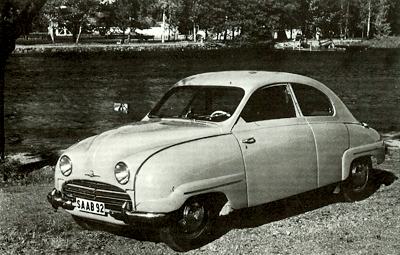 SAAB 92.
SAAB 92.
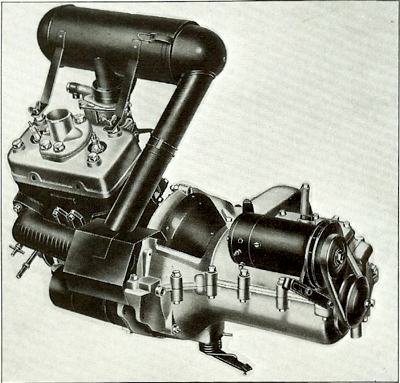 The two-stroke DKW type engine of the SAAB 92.
The two-stroke DKW type engine of the SAAB 92.
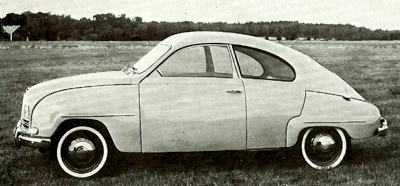 1955 SAAB 93, which was powered by a three-cylinder 750cc engine.
1955 SAAB 93, which was powered by a three-cylinder 750cc engine.
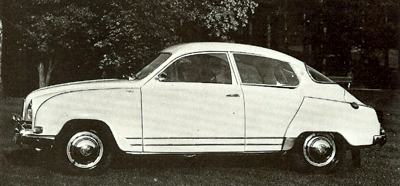 1964 SAAB 96 Sport, by then still powered by a two-stroke engine, but it had been enlarged to 850cc.
1964 SAAB 96 Sport, by then still powered by a two-stroke engine, but it had been enlarged to 850cc.
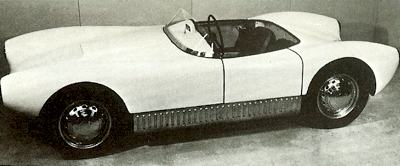 1956 SAAB Prototype Sports Convertible.
1956 SAAB Prototype Sports Convertible.
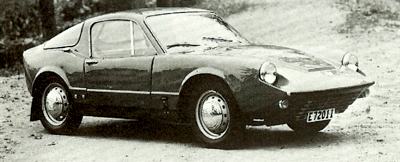 Up until its third series, the Sonnett used an 850cc two stroke 96 Sport engine. Pictured is a Sonnett II circa 1966.
Up until its third series, the Sonnett used an 850cc two stroke 96 Sport engine. Pictured is a Sonnett II circa 1966.
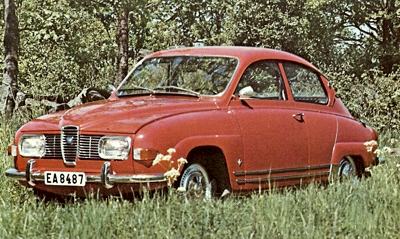 1968 SAAB 96, the first to be equipped with the four-stroke V4 Ford Taunus engine.
1968 SAAB 96, the first to be equipped with the four-stroke V4 Ford Taunus engine.
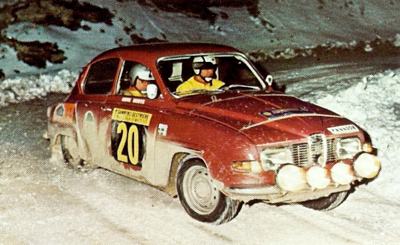 Hakan Lindberg in a 1970 rally event in his SAAB 96.
Hakan Lindberg in a 1970 rally event in his SAAB 96.
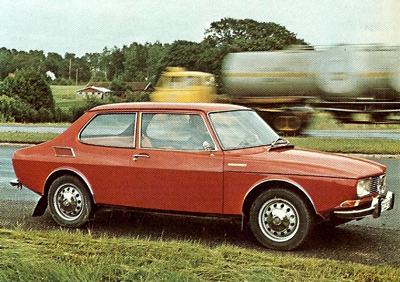 1968 SAAB 99.
1968 SAAB 99.
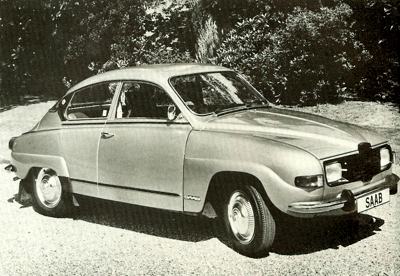 SAAB 96 in final production guise, as a 25th Anniversary Special.
SAAB 96 in final production guise, as a 25th Anniversary Special.
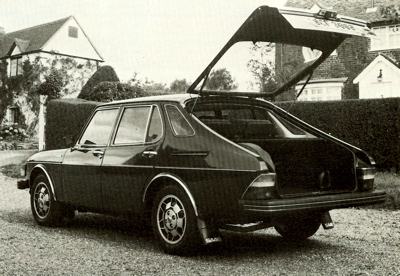
|
The SAAB 99
A new model emerged in 1967 - the Model 99, widely acclaimed as one of the world's most advanced cars, let alone an outstanding newcomer in its own class. Production began in 1968, then in 1970 the 99 acquired a headlamp wash/wipe facility, the first production model to have it as a standard fitting. The Swedish Automobile Association was sufficiently impressed to award Saab a gold medal for this - an accolade more than confirmed when the Swedish Government passed a law stipulating the headlamp wash/wipe system on all cars in Sweden from 1974 onwards.
In 1972 the 99 was elected Car of the Year by US experts for 'features which impart the car a unique position in the market'. These features included aluminum beam/cellular plastic block impact-absorbing bumpers and an automatically-heated driver's seat-both features which were subsequently copied by various other manufacturers, with impact-absorbing bumpers swiftly finding a place in the US safety regulations of the United States and in the proposed EEC regulations.
Scania-Vabis
In the same year the Saab 99 won the premier British safety award, the Don Safety Trophy. In 1968 Saab merged with the old-established Scania-Vabis truck firm, and in 1972 the integration of the car operation within a new Saab-Scania Group as one of five operating divisions was completed. The Scania Division is now the world's largest manufacturer of diesel vehicles (heavy and medium trucks) and diesel engines for marine and industrial use. The Aerospace division was the modern counterpart of the original aeroplane company and was based at the old Linkoping location.
From 1949 production had centred on Trollhattan, but further facilities were subsequently added at Kristinehamn, Arlov, Kramfors and Nykoping. Kristinehamn produces rear axles, front assemblies and plastic components, Arlov assembled V4 models, Kramfors produced radiators and cable harnesses, and Nykoping produced seat frames, fuel tanks and exhaust systems. The Scania Division produced engines for all Saab 99 cars at Sodertalje, and gearboxes in Gothenburg. There were also production facilities at Uusi-kaupunki, Finland, and at Mechelen, both supplying export markets. Total production of cars was 93,000 in 1974. Production was to continue at about the same level throughout 1975.
Saab pioneered group assembly, the first experiments starting in 1972 when a new two-liter engine was introduced on the 99 with light alloy cylinder head, overhead camshaft, and available with single or twin carburetors or with fuel injection, this latter version producing 118 bhp. The assembly line principle was abandoned at Sodertalje in favour of teams of three with the task of assembling complete engines. This system was flexible, with each member capable of doing all assembly jobs, and teams deciding to split the work as they saw fit. With one member absent, assembly could still continue. This approach to engine and other major component assembly was seen to combat the monotony of the conventional production line, often blamed for poor workmanship and even for a readiness among production workers to strike - anything to relieve the boredom.
The Envy Of Production Line Workers
Saab quote improved working conditions and greater job satisfaction for the employee, and improved quality of work and lower personnel turnover for the firm, as a result of this assembly method. They applied group working to departments other than engine assembly. Once a month self-governing groups ranging from two to eight people would meet to elect a leader who assigned the various tasks, usually on a weekly rota. Each group was responsible for their own quality control, placing orders for materials and for maintaining and servicing their equipment. It was also encouraged to suggest improvements in design and procedure. Anyone coming up with an acceptable idea shared the monetary prize offered by the company with the other members of their group.
The group was also allowed to grant time off to its members, and also determined who would join it when a vacancy occured. This micro-democracy system, the antithesis of the huge and soulless production line, was broadened by Saab in a step-by-step programme, and their progress was being watched with fascination by other car firms - management and workforce alike. Much of the design philosophy of the 'forties and 'fifties permeated through to Saabs for the next three decades, as proof of the soundness of their unconventional approach and their willingness to think boldly.
During the 1970's
Saab manufactured cars in two size classes, and though in each class only a handful of body variants was produced, different standards of trim, equipment levels, engine aspiration and transmission types meant that Saab could produce nearly 100 cars before they started again on exact duplication. The 95 and 96 models whose design dated from the late' 50s were still enjoyed strong market appeal to motorists seeking robust and well-proven cars, right through the 1970's. The 95 tag passed to the seven-seater wagon version, while the 96 was a sedan with a folding rear bench seat to give wagon-like load accommodation. Both had the V4 1498 cc overhead-valve engine, and featured a free-wheel for economy.
The SAAB 99
The freewheel was abandoned in 1971 in the 99. The base model was then a two-door sedan with modest trim levels and the basic two-liter Swedish engine-a Saab version of the I.7-liter Triumph Dolomite slant-four overhead-camshaft engine having been fitted in 1969, later superseded by a 1.85 version, and finally by Saab's own 1985 cc unit with light alloy cylinder head and an overhead camshaft. It had been carefully designed to minimise noise and reduce exhaust pollution. Though the straightforward 99 sedan had basic trim, it was constructed to the same safety levels as the rest of the range. This included a moulded glass fibre roof-lining which extended right down over the reinforcing members around the roof to provide heat and sound insulation as well as offering an impact-absorbing padding to protect passengers.
This design was introduced on all 99 models in 1973. The basic car also featured - in addition to 55lbs of primer, paint and underseal - an additional anti-corrosion treatment brought in in 1974. In addition, the whole engine compartment was sprayed with clear varnish. There were 99s with two, three, four and five-door bodies with higher trim levels including the heated driver's seat, and the Combi model (as Saab called its profile Wagon Back) with rear tailgate, folding rear seat creating a six-foot load platform and 53 cu ft of luggage space.
The SAAB 99 GLE
Top of the 'conventional' range was the 99 GLE, with a fuel-injection version of the 1985 cc engine (but still accepting low pollution 94 octane fuel) giving r oj mph. This car had the five-door body, injection-moulded aluminum wheels and the best interior of all Saab automotive products. Saab then developed the 99 Turbo rally car - which was based on the 1978 Turbo road car, the Group 4 version developing 240 bhp and 195 lb.ft. of torque, with aluminum panels bringing the weight down to a very competitive 1275 kilos.
While the world car market was flagging in 1975, Saab reported substantial sales gains in the first quarter, with a 40 per cent increase in Sweden over the same period of 1974, and a 27 per cent increase in export sales-an oyerall figure of 32 per cent. Sales in the US went up by over 20 per cent, and Finnish domestic sales rocketed 63 per cent. In that same quarter - otherwise, something of a sad turning point for the world motor industry - the Scania Division received an order from London Transport for 164 Metropolitan double-decker buses - and just to emphasise the diversified strength of Saab-Scania - the Aerospace Division, with more than 2000 military jet aircraft delivered to the air forces of four nations over the previous twenty years, received an order for 32 Saab Supporter T-17 trainers and observation aircraft from the Danish Defence Ministry. This brought Saab-Scania sales of this type of aircraft to more than 100 in six months.
From Swedish sales figures of a total 241,000 cars sold in 1977, Saab maintained their 1976 penetration of 13 per cent which compared with Volvo's 24.5 per cent. And yet another sign of the group's commercial sense - and success - was evidenced in 1975 when arrangements were made by Saab-Scania to import and distribute Auto-Bianchi cars in Sweden, Norway, Denmark and Finland, as a small-car supplement to Saab's own range.
In 1974, Saab ploughed four years of intensive research into initiating a development programme for a turbocharged version of the 99. Exhaustive bench testing of the 1985 cc ohc four-cylinder engine was felt necessary to prove the reliability and longevity of a turbo-driven engine for road use. The same ruthless destruction test programme was carried out under varied Continental road conditions with the aid of top Swedish rally drivers Stig Blomqvist and Per Eklund. Winter tests; high-temperature tests: high-altitude tests and ultra-high mileage tests-the Turbo was subjected to the lot. Only when it was good enough to pass them all by a safe margin did the Turbo become available on the world's markets.
The SAAB 900
Saab entered into an agreement with Fiat in 1978 to sell a rebadged Lancia Delta as the Saab 600 and jointly develop a new platform. The agreement yielded 1985’s Saab 9000, sister to the Alfa Romeo 164, Fiat Croma and Lancia Thema; all rode atop a common Type Four chassis. The 9000 was Saab’s first proper luxury car. 1978 was the first year for the 99’s intended replacement: the Saab 900. Nearly one million 900s would be produced, making it Saab’s best-selling model. A popular convertible version followed in 1986, all of which were made at the Saab-Valmet factory in Finland, making up nearly 20% of 900 sales.
In 1989, the Saab car division of Saab-Scania was restructured into an independent company, Saab Automobile AB, headquartered in Sweden; General Motors and Investor AB controlled 50% each. GM’s investment of US $600 million gave them the option to acquire the remaining shares within a decade. GM’s involvement spurred the launch of a new 900 in 1994. The new car shared a platform with the Opel Vectra. Due in large part to its success, Saab earned a profit in 1995 for the first time in seven years. 1997 marked Saab’s 50th anniversary as an automaker. The company used their jubilee owner’s convention to launch a replacement for the aging 9000: the Saab 9-5.
The 900 received a facelift and renaming complimentary to its new larger sibling: it would now be called the Saab 9-3. The 9-5 was the first Saab without a combi coupe bodystyle option in twenty years. Filling that space was a wagon variant, introduced in 1999. GM exercised their option to acquire the remaining Saab shares in 2000, spending US $125 million to the turn the company into a wholly-owned subsidiary. The newly close relationship yielded its first product in 2003’s all-new 9-3. The new model, marketed as a sport sedan, dropped Saab’s iconic hatchback in favor of a more conventional four-door approach. The model shared a platform and components with the Vectra again, but the relationship was much closer than had been in the past.
Badge Engineering Failures
Under GM’s direction, the badge-engineered Saab 9-2X (based on the Subaru Impreza) and Saab 9-7X (based on the Chevrolet Trailblazer) were introduced to the US market in 2005 with the hope of increase sales. Both models were a critical and commercial failure and were scrapped a few years after production. GM also delayed the 9-3 wagon by three years, canceled a 9-5 replacement in 2005 and announced a planned shift of production away from Saab’s historic home in Trollhättan to Opel’s factory in Rüsselsheim. Owing to fading fortunes across their entire business, GM announced that the Saab brand was “under review” in December 2008, a process which included the possibility of selling or shuttering the carmaker. Reportedly, 27 potential buyers emerged, including BMW, Fiat, Geely, Hyundai, Magna, Renault and Tata Motors; serious talks progressed with three bidders: Koenigsegg, Merbanco and Renco Group.
As the talks progressed, GM’s support receded, and the company went into administration, the Swedish equivalent of America’s Chapter 11 bankruptcy. Saab’s managing director Jan-Åke Jonsson said that this was "the best way to create a truly independent entity that is ready for investment". For its part, the Swedish government was reluctant to become involved, with Maud Olofsson, industry minister, saying: “The Swedish state and taxpayers in Sweden will not own car factories. Sometimes you get the impression that this is a small, small company but it is the world’s biggest automaker so we have a right to make demands.”
On June 16, 2009, Koenigsegg, the Swedish supercar maker, announced their intentions to purchase the brand from GM. The bid was backed by a group of Norwegian investors and the Chinese carmaker BAIC. The following month, both parties announced that GM had consented to the deal. There were outstanding financial details, but a loan from the European Investment Bank was expected to cover them. The loan was approved in October, but on November 24, Koenigsegg announced that it had “come to the painful and difficult conclusion that it could no longer carry out the acquisition.”
It was announced on December 14 that the Chinese automaker would acquire the intellectual property rights and production equipment for the previous generation Saab 9-3 and Saab 9-5 in a deal worth about US$197 million, which was enough for the company to run for three months. BAIC expressed their intent to create a new brand around the purchased technology and admitted to the purchase of "three overall vehicle platforms, two engine technologies and two transmission systems." Following the collapse of talks with Koenigsegg, GM announced that the brand would be eliminated in 2010 if it failed to secure a buyer before the close of 2009.
As talks with several firms failed, including the Netherlands-based boutique supercar maker Spyker, GM formally announced their intention to wind down the Saab brand. Undeterred, a new offer round materialized. Earlier bidders Spyker and Merbanco revised offers and were joined by a submission from Luxembourg-based Genii Capital, who boasted the support of F1 chief Bernie Ecclestone. GM continued accepting bids until a self-imposed deadline of January 7, 2010. Acknowledging that the chances for reaching a deal with any party were very slim, they pledged to evaluate each offer with due diligence.
Spyker Ownership
On January 26, 2010, General Motors confirmed that Spyker and General Motors had come to an agreement allowing Spyker to purchase Saab, subject to regulatory and government approval; the sale was completed on February 23, 2010. General Motors would continue to supply Saab with engines, transmissions and also completed vehicles in the shape of the new Saab 9-4x from GM's Mexican factory. The deal included a loan from the European Investment Bank, guaranteed by the Swedish government. It comprised $74m in cash up front.
